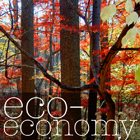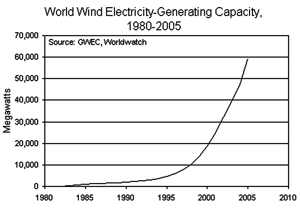
|
GLOBAL WIND POWER EXPANDS IN 2006 28 June 2006 :: Joseph Florence Global wind electricity-generating capacity increased by 24 percent in 2005 to 59,100 megawatts. This represents a twelvefold increase from a decade ago, when world wind-generating capacity stood at less than 5,000 megawatts. Wind is the world’s fastest-growing energy source with an average annual growth rate of 29 percent over the last ten years. In contrast, over the same time period, coal use has grown by 2.5 percent per year, nuclear power by 1.8 percent, natural gas by 2.5 percent, and oil by 1.7 percent.
Europe continues to lead the world in total installed capacity with over 40,500 megawatts, or two-thirds of the global total. These wind installations supply nearly 3 percent of Europe’s electricity and produce enough power to meet the needs of over 40 million people. The European Wind Energy Association (EWEA) has set a target to satisfy 23 percent of European electricity needs with wind by 2030. EWEA also notes that Europe has enough wind resources to meet the electricity demands of all of its countries. Denmark’s 3,100 megawatts of wind capacity meet 20 percent of its electricity needs, the largest share in any country. It ranks fifth in the world in installed capacity. Denmark is also the global leader in offshore wind power installations, with 400 megawatts of existing capacity. Globally, over 900 megawatts of offshore wind capacity will be installed by the end of 2006, all in Europe. The U.S. has installed 9,100 megawatts of wind power capacity. The U.S. wind industry installed a record-breaking 2,400 megawatts of wind power in 2005, up from installing just 370 megawatts in 2004 and 1,700 megawatts in 2003. This inconsistent growth is mostly due to the intermittent availability of the federal wind production tax credit (PTC) that currently stands at 1.9¢ per kilowatt hour. In mid 2005, Congress extended the PTC by two years, marking the first time lawmakers extended the tax credit without first allowing it to lapse. With the PTC guaranteed for the year, the U.S. wind industry projects that it will install 25 percent more capacity in 2006 than it did in 2005. Canada’s installed wind capacity of 680 megawatts at the end of 2005 is expected to increase to 1,200 megawatts by the end of 2006. While Canada’s federal government targets the installation of 4,000 megawatts of wind energy by 2010, its more ambitious provincial governments plan to install a combined 9,200 megawatts by 2015. Asian countries have installed nearly 7,000 megawatts of wind-generated electricity capacity. India has 4,400 megawatts of capacity, ranking fourth after Germany, the United States, and Spain. Wind power in China, currently at 1,260 megawatts, is beginning to flourish due to the country’s new Renewable Energy Law. This law provides tax incentives and subsidies for wind power and targets the development of 30,000 megawatts of wind capacity by 2010. Ambitious as these goals are, experts within the Chinese wind industry report that China could produce 400,000 megawatts of wind capacity by 2050. For comparison, China’s total electric power generation capacity at the end of 2003 was 356,100 megawatts. While three-quarters of all wind power has been installed in only five countries, the wind power installed in the rest of the world has grown by an average of 35 percent per year over the past ten years. Australia’s wind capacity almost doubled in 2005 to 710 megawatts. It leads the countries of the Pacific region, which, as a whole, have developed 890 megawatts. Latin America and the Caribbean have installed 210 megawatts of capacity. North African countries are also beginning to develop wind power and have installed 310 megawatts. Egypt and Morocco have installed 150 and 60 megawatts of wind capacity, respectively. The explosive growth of world wind power is due in large part to its increasing technological sophistication. Modern turbines are taller and have longer rotor blades than the turbines of 20 years ago, allowing them to produce up to 200 times more power. Since the “fuel” for wind power is free and unlimited, 75 to 90 percent of the costs of generating electricity with wind lie in manufacturing and constructing wind turbines and connecting them to the grid. Once turbines are installed, the remaining costs are primarily turbine operation and maintenance, land-use royalties, and property taxes. In the United States and around the world, energy markets are heavily regulated. Some 48 countries have regulations or laws in place that favor the growth of renewable energies. Examples of these include renewable portfolio standards that set a minimum for renewable energy purchases and tax incentives such as the United States’ PTC. However, decades of political and financial support to fossil fuel industries often undermine the competitiveness of wind energy. If environmental, social, and human-health costs were reflected in the economics of electricity generation, wind energy would become even less costly compared to energy derived from fossil fuels. Unlike conventional power plants, wind electrical generation does not release greenhouse gases that warm the climate or other polluting emissions. Wind power provides more benefits than just affordable clean energy. The prices of wind-generated electricity are stable and not subject to the price volatility of fossil fuels. Wind power supports local economic development since the jobs, royalties, and tax revenues from wind-generated electricity production tend to stay in the community. And since wind is inexhaustible it offers long-term energy security that electricity derived from nonrenewable fossil fuels cannot. [e]
Originally Published online: 28 June 2006
BACKGROUND: State authorities in Texas have announced plans to build the nation's largest offshore wind farm. The facility would be built about 10 miles off Padre Island in the Gulf of Mexico and would consist of 500 wind-harvesting turbines, 400 feet in height. [Full Story] THE COMING DECLINE OF OIL When the price of oil climbed above $50 a barrel in late 2004, public attention began to focus on the adequacy of world oil supplies —and specifically on when production would peak and begin to decline. Analysts are far from a consensus on this issue, but several prominent ones now believe that the oil peak is imminent. [Full Story] GREEN LIGHT FOR RENEWABLE FUELS Renewable fuels have enjoyed a lot of attention in recent months, in a market driven by escalating oil costs, strained fuel stocks, worsening environmental degradation, and promises by the G8 to reduce carbon emissions. Revelations about the vulnerabilities inherent in the fossil fuel infrastructure, together with new technological advances in wind- and solar-based power generation mean renewables are now directly competitive with traditional fuel sources. [Full Story] WHY WIND IS SMARTER Wind energy offers something no carbon-based fuel can offer: zero emissions, zero cleanup, local control and reasonable local supply everywhere on Earth, and it is 100% non-climate disruptive and essentially infinitely renewable. In fact, the overall global wind resource far exceeds our capacity even to harness or to use it. As of 2003, Pentagon-commissioned research had found that just 3 wind-rich midwestern states possess sufficient wind resources to power the entire US economy with existing wind-turbine technology. [Full Story] |
|||||||||||||||||||||||||||
|
||||||||||||||||||||||||||||












